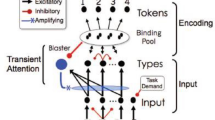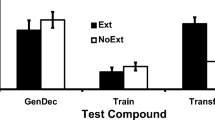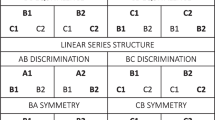Abstract
The issue of necessary and sufficient factors (pairing-contiguity vs. contingency-correlation) in classical (Pavlovian) excitatory conditioning is examined: first, in terms of definitional (logical) and manipulational requirements of “necessary” and “sufficient”; second, in terms of Boolean logic test models indicating experimental and control manipulations in tests of pairing and contingency as necessary and sufficient factors; and, third, by a selective review of reference experiments showing appropriate experimental and control manipulations of pairing and contingency indicated in the Boolean logic test models. Results of examination show pairing-contiguity as the sole necessary and sufficient factor for excitatory conditioning, while contingency-correlation is conceptualized as a modulating factor controlling minimal-maximal effects of pairingcontiguity. Reservations and diagnostic experiments are indicated to assess effects of uncontrolled conditioned stimulus—unconditioned stimulus\((\overline {CS} - US)\) probability characteristics (e.g., p (CS ∩ US)/p\((\overline {CS} \cap US)\) in truly random (TR) schedule manipulations). Similar analysis of conditioned inhibition reveals insufficient evidence to support a choice among current alternatives.
Similar content being viewed by others
References
Annau, Z., and Kamin, L. J. The conditioned emotional response as a function of intensity of the US.Journal of Comparative and Physiological Psychology, 1961,54, 428–432.
Ayres, J. J. B., Benedict, J. O., and Wichter, E. S. Systematic manipulation of individual events in a truly random control procedure in rats.Journal of Comparative and Physiological Psychology, 1975,68, 97–103.
Baker, A. G. Conditioned inhibition arising from between sessions negative correlation.Journal of Experimental Psychology: Animal Behavior Processes, 1977,3, 144–155.
Benedict, J. O., and Ayres, J. J. B. Factors affecting conditioning in the truly random control procedure in the rat.Journal of Comparative and Physiological Psychology, 1972,78, 323–330.
Boakes, R. A., and Halliday, M. S., (Eds.).Inhibition and Learning. New York: Academic Press, 1972.
Dickinson, A., and MacKintosh, N. J. Classical conditioning in animals.Annual Review of Psychology, 1978,24, 587–612.
Frey, P. W., and Sears, R. T. Model of conditioning incorporating the Rescorla-Wagner associative axiom, a dynamic attention process and a catastrophe rule.Psychological Review, 1978,85, 321–340.
Gibbon, J. The contingecy problem in autoshaping. In C. M. Locurto, H. S. Terrace, and J. Gibbon (Eds.),Autoshaping and Conditioning Theory. New York: Academic Press, 1981.
Gormezano, I. Classical conditioning. In B. Sidowski (Ed.),Experimental Method and Instrumentation in Psychology. New York: McGraw-Hill, 1966.
Gormezano, I., and Coleman, S. R. Effects of partial reinforcement on conditioning, conditional probabilities, asymptotic performance and extinction of the rabbit’s nictitating membrane response.Pavlovian Journal of Biological Science, 1975,10, 13–22.
Gormezano, I., and Kehoe, E. J. Classical conditioning: Some methodological-conceptual issues. In W. K. Estes (Ed.),Handbook of Learning and Cognitive Processes. Hillsdale: Lawrence Erlbaum Associates, 1975.
Gormezano, I., and Moore, J. W. Classical conditioning. In K. H. Marx (Ed.),Learning: Processes. London: Collier-MacKmillan, 1969.
Hearst, E. W. Some persistent problems in the analysis of conditioned inhibition. In R. A. Boakes and M. S. Halliday (Eds.),Inhibition and Learning. New York: Academic Press, 1972.
Holmes, J. G. Effects of backward pairings of the CS and US on classical conditioning of the nictitating membrane response in the rabbit. A doctoral dissertation. Iowa City: University of Iowa, 1971.
Jenkins, H. M., Barnes, R. A., and Barrera, F. J. Why autoshaping depends on trial spacing. In C. M. Locurto, H. S. Terrace, and J. Gibbon (Eds.),Autoshaping and Conditioning Theory. New York: Academic Press, 1981.
Kahane, H.Logic and Philosophy. Belmont, Cal.: Wadsworth Publishing, 1978.
Kamin, L. J. Attention-like processes in classical conditioning. In M. R. Jones (Ed.),Miami Symposium in the Prediction of Behavior: Aversive Stimulation. Miami: University of Miami Press, 1968.
Kamin, L. J. Predictability, surprise, attention and conditioning. In B. A. Campbell and R. M., Church (Eds.),Punishment. New York: AppletonCentury-Crofts, 1969.
Keller, R. J., Ayres, J. J. B., and Mahoney, W. J. Brief versus extended exposure to truly random control procedures.Journal of Experimental Psychology: Animal Behavior Processes, 1977,3, 53–65.
Kimble, G. M.Hilgard and Marguis’ Conditioning and Learning. New York: Appleton-Century Crofts, 1961.
Kremer, E. F. The Rescorla-Wagner model: Losses in associative strength in compound conditioned stimuli.Journal of Experimental Psychology: Animal Behavior Process, 1978,4, 22–36.
Kremer, E. F. Truly random and traditional control procedures in CER conditioning in the rat.Journal of Comparative and Physiological Psychology, 1977,76, 441–448.
Kremer, E. F. The truly random control procedure: Conditioning to the static cues.Journal of Comparative and Physiological Psychology, 1974,87, 700–707.
Kremer, E. F., and Kamin, L. J. The truly random control procedure: Associative or nonassociative effects in rats.Journal of Comparative and Physiological Psychology, 1971,74, 203–210.
Lubow, R. E., and Moore, A. U. Latent inhibition: The effect of non-reinforced pre-exposure to the conditioned stimulus.Journal of Comparative and Physiological Psychology, 1959,52, 415–419. 229
Lubow, R. E. Latent inhibition.Psychological Bulletin, 1959,52, 415–419.
Lynch, J. J., and Kakigi, S. The CS-US interval in classical conditioning: Some theoretical implications for learning theory. Unpublished observations
Mackintosh, N. J. A theory of attention: Variations in Associability of stimuli with reinforcement.Psychological Review, 1975,82, 276–298.
MacKintosh, N. J. Cognitive or associative theories of conditioning: Implications of an analysis of blocking. In S. H. Hulse, H. Fowler, and W. K. Honig (Eds.),Cognitive Process in Animal Behavior. Hillsdale: Lawrence Erlbaum Associates, 1978.
Maleske, R. T., and Frey, P. W. Blocking in eyelid conditioning: Effect of changing the CS-US interval and introducing an intertriai interval.Animal Learning and Behavior, 1979,7, 452–456.
Marchant, H. G. III, Mis, F. W., and Moore, J. W. Conditioned inhibition of the rabbit’s nictitating membrane response.Journal of Experimental Psychology, 1972,95, 408–411.
McAllister, W.R. Conditioning as a function of CS-US interval.Journal of Experimental Psychology, 1954,45, 417–422.
McAllister, W. R., and McAllister, D. E. Behavioral measurement of conditioned fear. In F. R., Brush (Ed.),Aversive Conditioning and Learning. New York: Academic Press, 1971.
Mis, E. W. A mid-brain stem circuit for conditioned inhibition of the nictitating membrane response in the rabbit (Oryctolagus cunicuius).Journal of Comparative and Physiological Psychology, 1977,91, 975–988.
Moscovitch, R., and LoLordo, V. M. Role of safety in the backward fear conditioning procedurr.Journal of Comparative and Physiological Psychology, 1968,66, 673–678.
Pavlov, I. P.Conditioned Reflex. London: Oxford University Press, 1927.
Pearce, J. M., and Hall, W. A. A model for Pavlovian learning: Variations in the effectiveness of conditioned but not of unconditioned stimuli.Psychological Review, 1980,87, 532–552.
Prokasy, W. F., and Gormezano, I. The effect of US omission in classical aversive and appetitive conditioning in rabbits.Animal Learning and Behavior, 1979,7, 80–88.
Reiss, S., and Wagner, A. R. CS habituation produces a “latent inhibition” effect but no active conditioned inhibition.Learning and Motivation, 1972,2, 237–245.
Rescorla, R. A. Conditioned inhibition and extinction. In A. Dickinson and R. A. Boakes (Eds.),Mechanisms of Learning and Motivation: A Memorial Volume to Jerzy Konorski. Hillsdale: Lawrence Erlbaum Associates, 1979.
Rescorla, R. A. Conditioned inhibition of fear resulting from negative CS-US contingencies.Journal of Comparative and Physiological Psychology, 1969(a),67, 504–509.
Rescorla, R. A. Pavlovian conditioned inhibition.Psychological Bulletin, 1969(b),72, 77–94.
Rescorla, R. A. Pavlovian conditioning and its proper control procedures.Psychological Review, 1967,84, 88–97.
Rescorla, R. A. Probability of shock in the presence and absence of CS.Journal of Comparative and Physiological Psychology, 1968,66, 1–5.
Rescorla, R. A. Some implications of a cognitive perspective in Pavlovian conditioning. In S. H. Hulse, H. Fowler, and W. K. Honing (Eds.),Congnitive Processes in Animal Behavior. Hillsdale: Lawrence Erlbaum Associates, 1978.
Rescorla, R. A. Variations in the effectiveness of reinforcement and nonreinforcement following prior inhibitory conditioning.Learning and Motivation, 1971,2, 113–123.
Rescorla, R. A., and Solomon, R. L. Two-process learning theory: Relationships between Pavlovian conditioning and instrumental learning.Psychological Review, 1967,84, 151–182.
Rescorla, R. A., and Wagner, A. R. A theory of Pavlovian conditioning: Variations in the effectiveness of reinforcement and nonreinforcement. In A. H. Black and W. F. Prokasy (Eds.),Classical Conditioning: II. New York: Appleton-Century-Crofts, 1972.
Schneiderman, N., and Gormezano, I. Conditioning of the nictitating membrane response of the rabbit as a function of the CS-USinterval.Journal of Comparative and Physiological Psychology, 1964,57, 188–195.
Seligman, M. E. P. Control group and conditioning: A comment on operationism.Psychological Review, 1969,76, 484–491.
Siegel, S., and Domjan, M. Backward conditioning as an inhibitory procedure.Learning and Motivation, 1971,2, 1–11.
Stebbing, S. L.A Modern Introduction to Logic. New York: Harper & Row, 1961.
Suiter, R. D., and LoLordo, V. M. Blocking of inhibitory Pavlovian conditioning in the conditioned emotional response procedure.Journal of Comparative and Physiological Psychology, 1971,76, 137–144.
Wagner, A. R. Stimulus selection and a “modified continuity theory.” In G. H. Bower and J. R. Spence (Eds.),The Psychology of Learning and Motivation. Vol. 33. New York: Academic Press, 1969.
Wagner, A. R., Mazur, J. E., Donegan, N. H., Pfautz, P. L. Evaluation of blocking and conditioned inhibition to a CS signalling a decrease in US-intensity.Journal of Experimental Psychology: Animal Behavior Processes, 1980,6, 376–385.
Wagner, A. R., and Rescorla, R. A. Inhibition of Pavlovian conditioning: Application of a theory. In R. A. Boakes and M. S., Halliday (Eds.),Inhibition and Learning. New York: Academic Press, 1972.
Willmer, J. A. Blocking of taste aversion by prior pairings of exteroceptive stimuli with illness.Learning and Motivation, 1978,9, 125–140.
Author information
Authors and Affiliations
Rights and permissions
About this article
Cite this article
Damianopoulos, E.N. Necessary and sufficient factors in classical conditioning. Pav. J. Biol. Sci. 17, 215–229 (1982). https://doi.org/10.1007/BF03001277
Issue Date:
DOI: https://doi.org/10.1007/BF03001277




